Chatbot / chatops
https://www.freecodecamp.org/news/how-to-build-an-ai-chatbot-with-redis-python-and-gpt
Rasa
Open source machine learning tools for developers to build, improve, and deploy text-and voice-based chatbots and assistants
- The core of building a Rasa assistant is providing examples that your system learns from
- How do people say things?
- How do conversations go?
Types of chatbot
- Rule-based Chatbots / Workflow chatbots
- Intellectually Independent Chatbots
- AI-powered Chatbots
Types of product chatbots
Customer Service Bots
- Welcome Bots
- Resolution Bots
- Navigation Bots
E-Commerce Bots
- Sales Bots
- Product Recommendation Bots
- Billing Bots
- Order Management Bots
https://www.freshworks.com/live-chat-software/chatbots/chatbot-ideas-blog
Task Oriented Dialogue System
- Task Oriented - Users want to accomplish something (task they want to achieve)
- Dialogue system - Talking with an automated system in a two-way conversation
- Chit chat bot - Goal is to have an ongoing conversation without necessarily doing anything
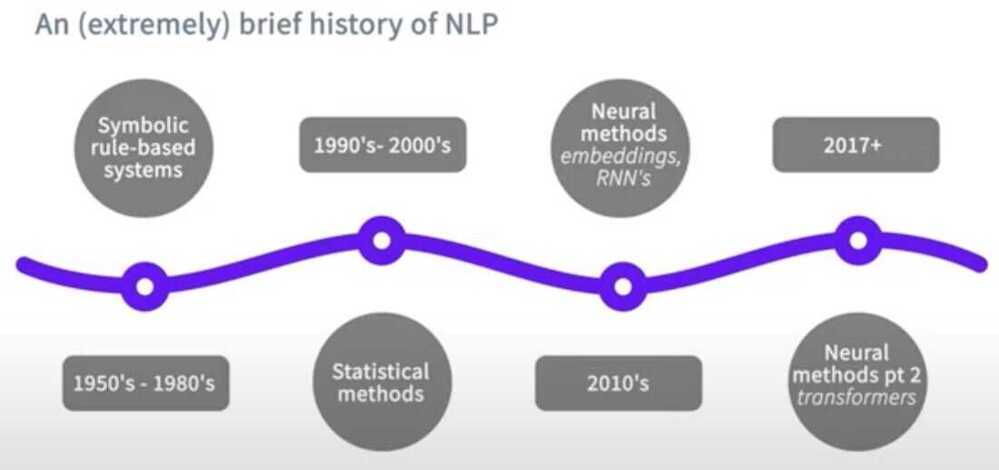
State machines vs neural methods
-
Understanding Text
- NLU - raw text in, machine-readable information out
- Rule based
- Example: A regular rexpression that finds and extracts email addresses
- You don't need much/any data for these approaches
- They can run very fast
- But they're not very good at handling things they haven't seen before
- Neural
- Example: A transformer-based model (e.g. DIET) that sorts text into intents based on examples it's been provided
- Require training examples (in general, the more the better)
- But they're very good at handling things they haven't seen before, making "informed guesses"
A Rasa assistant might use both, but the neural methods are the core of the framework
-
Deciding what do do next
- Dialog policy - Given the conversation so far, what should your assistant say or do next?
- Rule-based
- Example: A big dialog tree of all possible paths a conversation can take
- This is a traditional approach to dialog and it can work well in some cases
- But they can't hand digressions and are a bit of a pain to extend/maintain
- Neural
- A transformer-based model (e.g. TED) that picks the next best turn based on the conversation so far and all the conversations it's been trained on
- Require training examples (in general, the more the better)
- But this approach let's users have a more natural conversations, even if they say things in a different order every time
Both 1 and 2 is recommended to use in tandem
How to make sure conversations work (and improve over time)
- The Rasa approach is
- Flexible, every conversation might be unique
- Works better the more high-quality training data you have
- How do you make sure conversations work?
- Manually reviewing and annotating conversations
- How do you make sure conversations improve over time?
- Correct any errors your assistant made in a conversation, then add it to the training data, retrain and redeploy
- A Rasa conversational AI ystem itsn't static, It changes and adapts over time
- We call this process "conversation-driven development"
Files
- domain.yml
- config.yml
- Data files
- nlu.yml
- stories.yml
- rules.yml
Commands
pip3 install --upgrade rasa
rasa init
rasa train
rasa shell
rasa shell --debug
rasa -h
Domain.yml
The domain file is a directory of everything our assistant "knows"
- Responses: These are the things the assistant can say to users
- Intents: These are categories of things users say
- affirm
- deny
- greet
- thankyou
- goodbye
- search_concerts
- search_venues
- compare_reviews
- bot_challenge
- how_to_get_started
- Slots: These are variables remembered over the course of a conversation
- Entities: These are pieces of information extracted from incoming text
- Forms & actions: These add application logic and extend what your assistant can do
Data
- The text data used to pretrain any models or features you're using (e.g. language models,, word embeddings, etc.)
- User-generated text
- Patterns of conversations
- Examples:
- Customer support logs
- User conversations with your assistant
- How should conversations with your chatbot go?
- Stories
- Rules
- How do users say things?
- Intents
- If you have data
- Modified content analysis
- Go through data (or sample) by hand and assign each datapoint to a group
- If no existing group fits, add a new one
- At given intervals, go through your groups and combine or separate them as needed
- Start with 2-3 passes through your dataset
- Can't you just automate this i.e. intent discovery and classification
- It's easiest to use interactive learning to create stories
- Modified content analysis
- If you don't have data
- Start with the most common intent
- Start with the smallest possible number of intents (that conver your core use case)
- Everything else goes in and out of scope intent
- If your assistant can't handle something, give users an escape hatch right away
- Additional intents will come from user data
- Have fewer intents
- Rasa style CDD
- You only need to start with the most popular, important intents & a way to handle things outside them
- Continue to build from there if that's what users need
- Human reasons
- More intents = more training data, maintenance, documentation
- More intents = annotation more difficult
- ML reasons
- Transformer classifiers scale linearly with the # of classes
- Entity extraction (esp with very lightweight rule-baed system like Duckling) is often faster
- Rasa style CDD
- Paring down intents
- Don't use intents as a way to store information (use slots instead)
- Consider to combine, if a lot of same tokens show up in training data for two intents
- Example
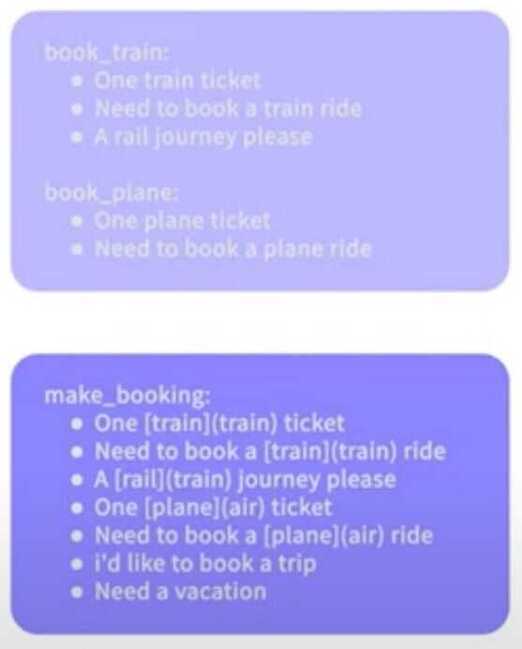
- Training data for an intent
- User-generated > synthetic
- Each utterance should unambigously match to a single intent
- You can verify this using human sorting & inter-rater reliability
- Is an utterance ambiguous?
- Use end-to-end instead (the raw text as training data w/out classifying it)
Stories
Training data to teach your assistant what it should do next
- If you have conversational data, start with those patterns
- Generate your own conversational patterns
- It's easiest to use interactive learning to create stories
- Start with common flows, happy paths
- Then add common errors/digressions
- Once your model is trained, add more data from user conversations
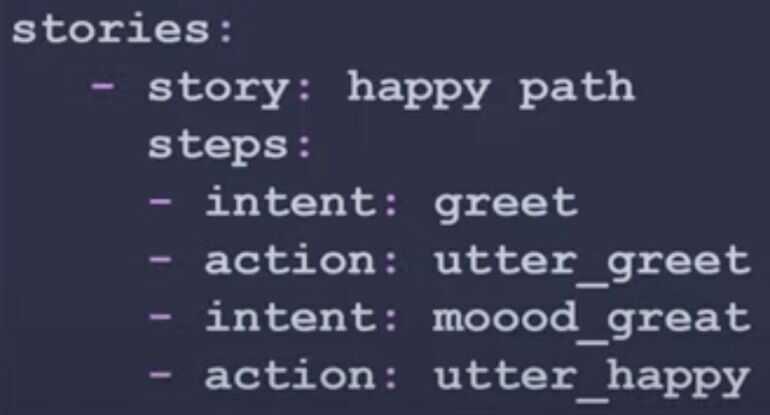
Or statements
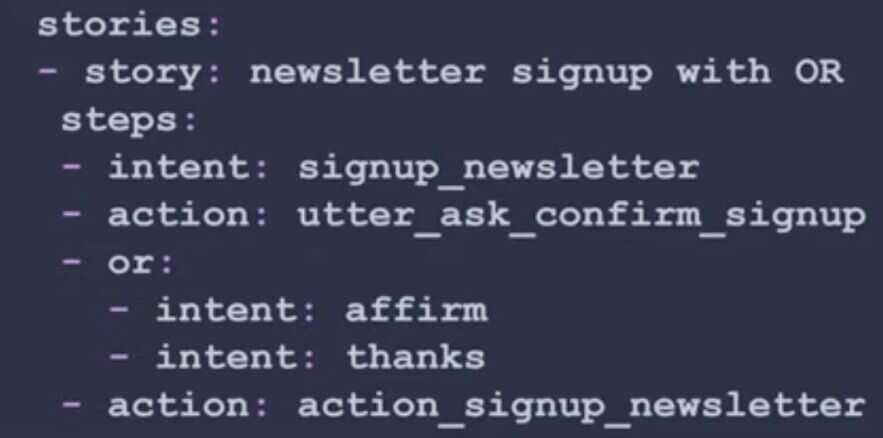
Checkpoints

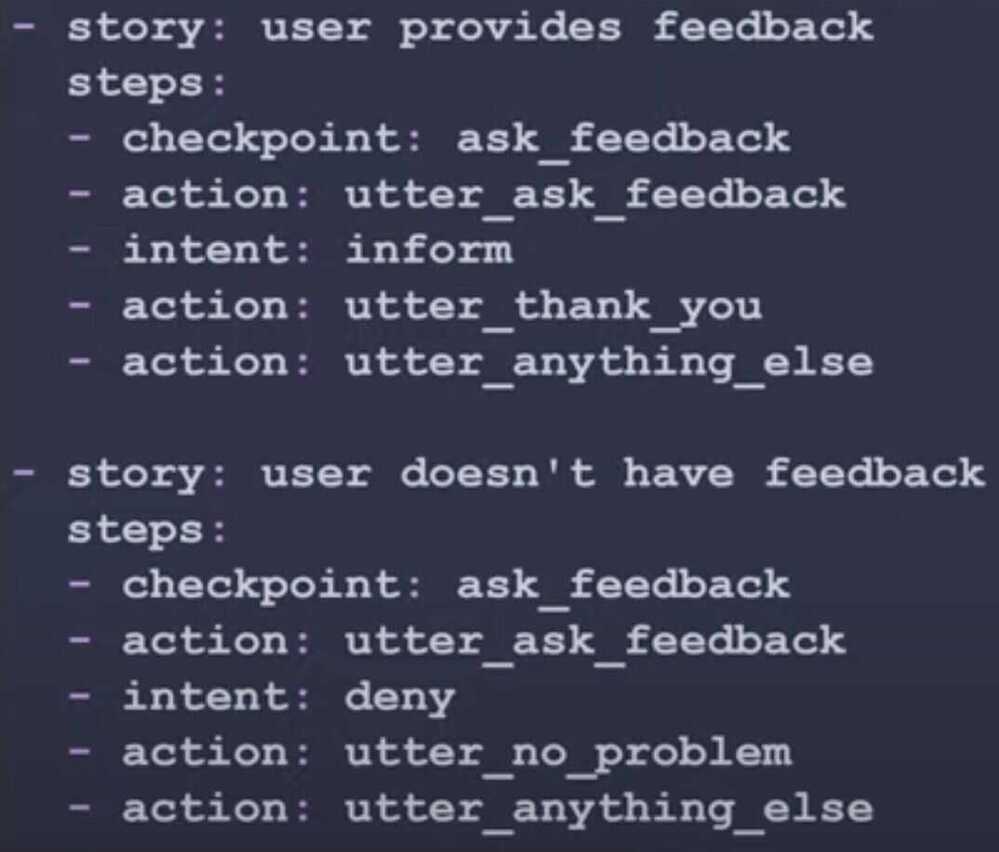
Rules
A way to describe short pieces of conversations that always go the same way
- User rules for one-off interactions (checking account balance, checking if this is a bot)
- Don't use rules for multi-turn interactions
- Don't use OR statements and checkpointing often
- Don't write out every possible conversation flow start to finish
- Don't delay user testing
Entities
Entities are structured pieces of information inside of a user message
An entity can be any important detail that your assitant could use later in a conversation:
- Numbers
- Dates
- Country names
- Product names, etc
There are 3 ways entities can be extracted in Rasa
-
Using pre-build models
- Duckling for extracting numbers, dates, url, email addresses
- SpaCy - for extracting names, product names, locations, etc
-
Using Regex
- For entities that match a specific pattern (e.g. phone numbers, postcodes, etc.)
-
Using ML
- For extracting custom entities

The output of the entity extraction is a snippet of JSON which contains the details of
- Entity category ("city")
- Entity value ("New York City")
- Confidence levels
- The component that extracted the entity
Synonyms
Synonyms can be used to map the extracted values to a single standardized value
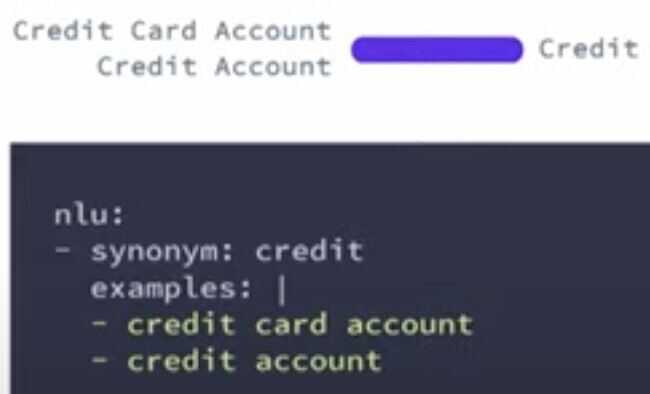
OR during entity extraction
Others
- https://rasa.com/docs/action-server/knowledge-bases
- https://github.com/RasaHQ/tutorial-knowledge-base
- NER - Rasa NLU for Entity Extraction
Learning
- https://learning.rasa.com/certification-study-guide/
- Conversational AI with Rasa Open Source 3.x
- Rasa 3.x Tutorials
- https://rasa.com/docs
- Algorithm Whiteboard
- Level 3 AI Assistant Conference 2021
Demo
http://financial-demo.rasa.com/guest/conversations/production/d379406177e14dcfa67ed47ebfdd9106
https://rasa.com/showcase/albert-heijn
Responses
- https://rasa.com/docs/rasa/responses
- https://rasa.com/blog/response-retrieval-models
- https://rasa.com/docs/rasa/chitchat-faqs
Rasa 3.0
- https://rasa.com/blog/updated-learning-resources-for-rasa-open-source-3-0
- https://rasa.com/blog/slots-in-rasa-open-source-3-0
- https://rasa.com/blog/markers-in-rasa-open-source-3-0
- https://rasa.com/blog/bending-the-ml-pipeline-in-rasa-3-0
- https://rasa.com
- https://github.com/rasaHQ/
- https://blog.rasa.com
- https://github.com/RasaHQ/helpdesk-assistant
- Building Your First Chatbot in Python || Rachael Tatman
- https://enterprisebot.ai/case-studies
- https://www.freecodecamp.org/news/python-project-how-to-build-your-own-jarvis-using-python
- Conversational AI with Rasa: Integration with a Website
- Webinar: New Chatbot Starter Packs for Banking and IT Support
- https://github.com/RasaHQ/financial-demo
- https://github.com/RasaHQ/helpdesk-assistant
- https://rasa.com/blog/rasa-example-helpdesk
Solutions
- https://rasa.com/solutions/lead-generation-sales
- https://rasa.com/solutions/customer-service-automation
- https://info.rasa.com/poc-to-production-whitepaper
Chatbot strategy
